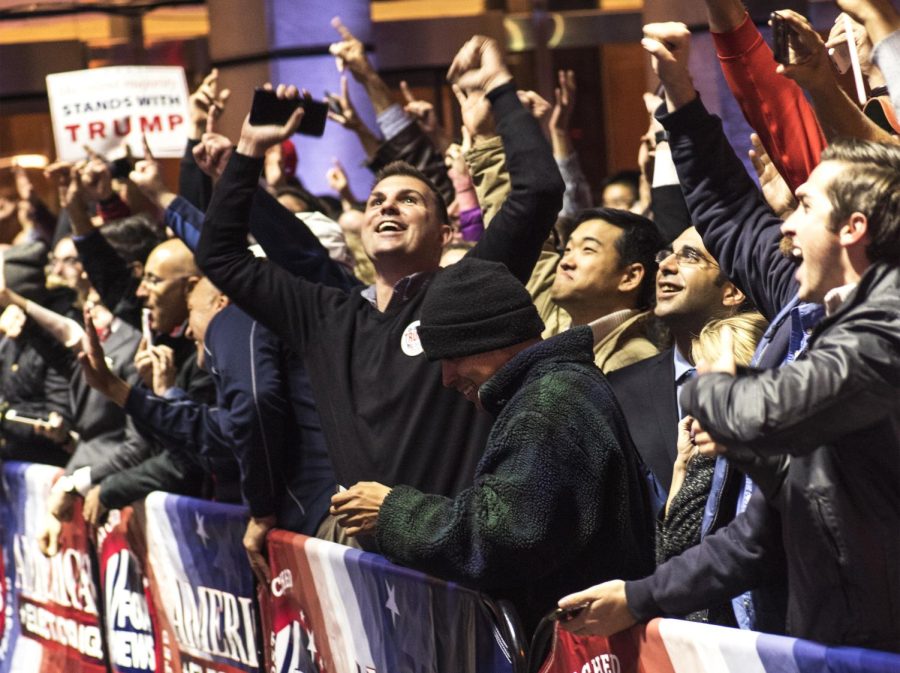Opinion: A red future for media
Supporters of Republican presidential nominee Donald Trump cheer outside the News Corp. Building in New York City during the early hours of Wednesday, Nov. 9, 2016, when Trump was announced the victor of the presidential election.
November 9, 2016
Early Wednesday morning I stood among hundreds of New Yorkers outside Fox News headquarters on the Avenue of the Americas, awaiting the news of who would become the next U.S. president.
I arrived at the plaza just after 1 a.m., and was greeted by hordes of red “Make America Great Again” hats and blue Trump-Pence signs. New York City Police officers stood guard at the edge of the sidewalk, monitoring the activity of the mass that had arrived to watch the five televisions broadcasting the Fox News anchors, who sat inside.
While more states went to Republican presidential nominee Donald Trump, a group of five white men sporting red, white and camouflage Trump hats began to sing Bananarama’s “Na Na Hey Hey Kiss Him Goodbye” amid the chants of “Killary” and “Hillary for prison” that had begun to echo throughout the crowd.
The news network announced Trump’s presidency win at just after 2:30 a.m. When the silver words “Trump wins presidency” flashed across the outside monitors, the noise was deafening.
People hugged. Fists were raised in the air. Shouts of “Trump” and “finally” drowned out the news anchors on screen.
I’ve covered my fair share of political rallies and events for both major parties as credentialed media for The Kent Stater over the last nine months. By now, it’s relatively easy to compare the atmosphere of the crowd gathered to see each candidate.
Clinton supporters have always been hopeful. The prospect of a woman president was something that brought with it promise.
As a part of the media, I never questioned or hesitated to approach these people to ask them questions on why they chose their candidate. We were never pointed out by Clinton and scorned for biased reporting. The crowd wasn’t ever egged on by the candidate at the podium to boo at the cameras and reporters huddled in the media pit.
Not much attention was paid to us.
And that was okay; we’re the media. Our job is to simply report what takes place, not be the story. The atmosphere at a Trump venue was different — less inviting. The candidate blatantly pointed out the media pit, claiming biased reporting was being done before their eyes.
The first time I attended a Trump rally and was subjected to this, it honestly rattled me. The crowd shouting at the media pit, men and women of all ages waving their campaign signs over the barred fence at the reporters who turned their phones and cameras toward them, to document the moment. At one of my last rallies for the election season, a man outright spit in my face as I went to take his picture.
For the record, I got the picture.
It never turned uncontrollably violent. Punches weren’t thrown, blood wasn’t shed. Yet the atmosphere of those rallies caused my stomach to churn. The scrutiny I was subjected to not just as a journalist, but as someone who doesn’t look like your average, white American citizen, has stuck with me.
But the more I’ve covered these types of rallies and experienced this sort of treatment, the less affected I’ve been by it. It’s almost as if I’ve become desensitized to how I, as a member of the media, am viewed. I’ve simply accepted it and moved on because, I tell myself, I’m simply there to report on it. And honestly, I thought myself and the rest of the media wouldn’t have to deal with the Republican nominee after Nov. 8.
As I stood among those Trump supporters and watched as Trump was declared the winner, it hit me just how serious and detrimental the consequences of this election’s outcome may be for myself and fellow journalism majors as we graduate and enter our field of choice as the “watchdogs of society.”
It’s going to be — and, really, already is — one hell of a time to be a member of the media.
Alex Delaney-Gesing is a senior reporter, contact her at [email protected].












